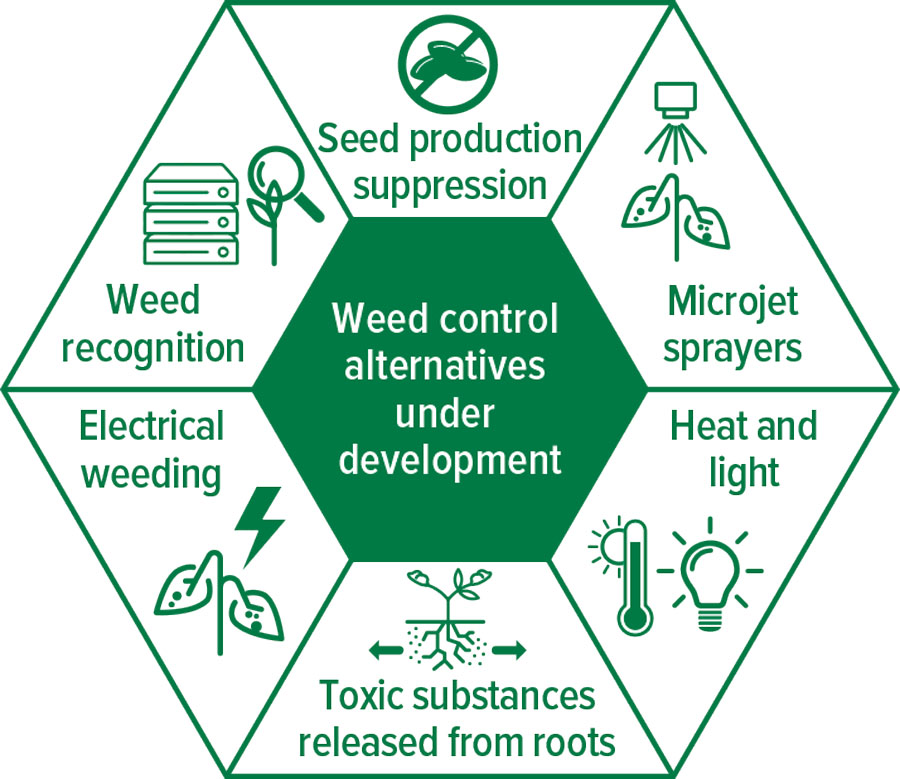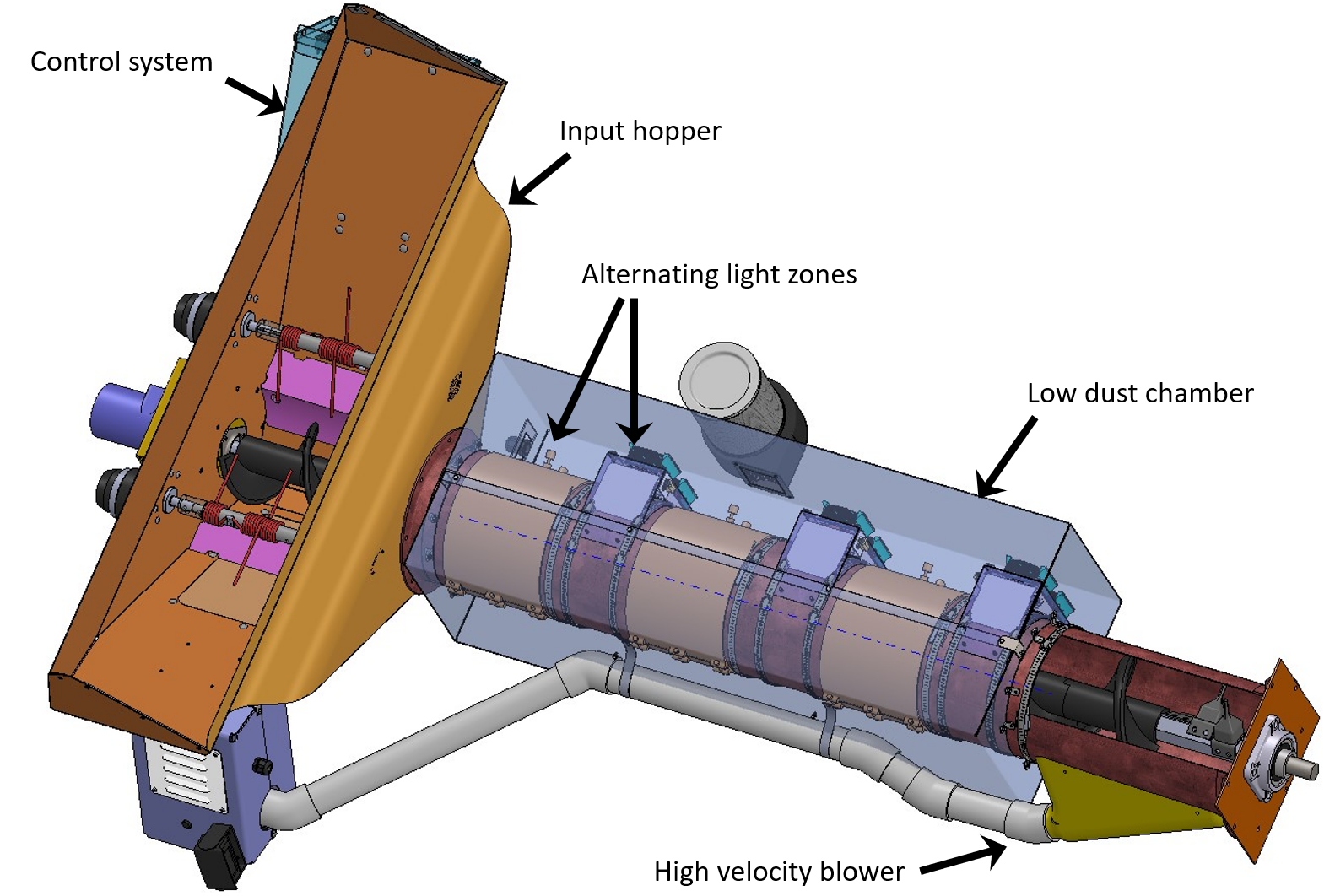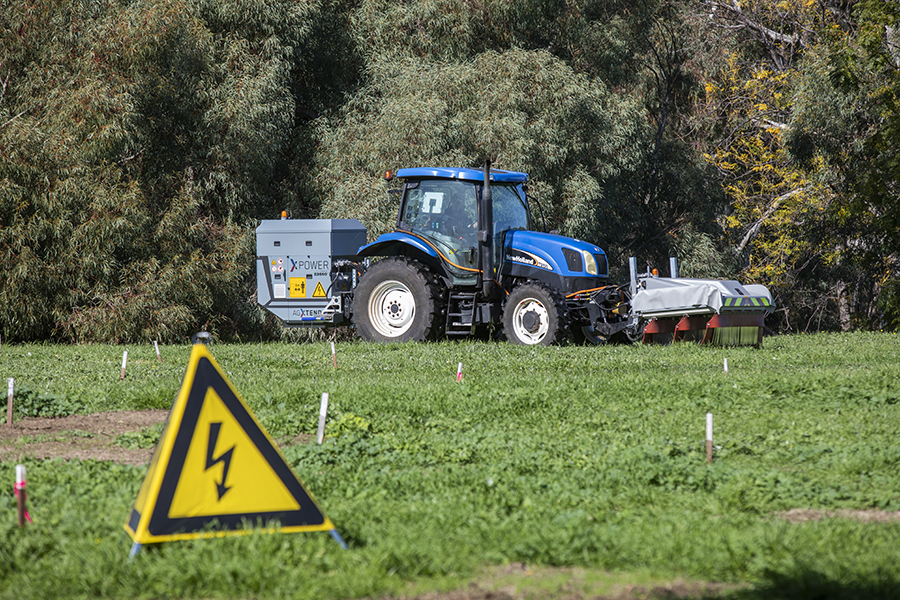Novel technologies under development in the US and Australia could offer a broader range of tools to deal with weeds.
Charles Sturt University Professor Michael Walsh outlined six developments at the 2024 GRDC Updates.

His observations came from a fact-finding mission he made as part of a Fulbright Scholarship. This included six months in the US at Kansas State University and Texas A&M University.
Heating weeds
One technology being developed by Global Neighbor, a start-up based in Ohio, is a method for killing weed seeds using high-intensity blue and mid-wave infrared heating (Figures 1a and 1b).
Figure 1a: A diagram showing where the Weed Seed Destroyer would fit into a harvester.

Source: Global Neighbor.
Figure 1b: The layout of the Weed Seed Destroyer prototype.

Source: Global Neighbor.
Professor Walsh said the intensity of the blue light was 30 times more than natural sunlight. Combined with mid-wave infrared radiation, it kills weed seeds in chaff, potentially within seconds.
“Global Neighbor is pursuing this opportunity with a development called the Weed Seed Destroyer,” he said.
“The technology is still under development, with prototypes in benchtop and paddock testing.”
After two seasons of field testing in the US, the Weed Seed Destroyer was progressing towards commercialisation.
While working at the University of Western Australia, Professor Walsh determined that a benchtop Weed Seed Destroyer (Figure 2) could kill more than 90 per cent of annual ryegrass seed in wheat chaff.
Figure 2: A benchtop Weed Seed Destroyer prototype tested at the University of Western Australia.

Source: Michael Walsh.
“Although our initial results are encouraging, we don’t know how this approach works in paddock conditions across a range of weed species and crop-chaff combinations in varying harvesting conditions,” he said.
Microjet sprayers
Professor Walsh said researchers at the University of California (UC Davis) were exploring microjet sprayers to target weeds with low-volume precision herbicide treatments.
The technology identifies weeds and triggers a solenoid to spray low herbicide volumes to target weeds precisely (Figure 3).
Figure 3: Precise weed targeting (a) with microjet sprayers (b)

Source: Raja et al. 2023.
At North Carolina State University, Professor Walsh saw an inkjet label printer deployed with 32 individually controllable valves re-engineered to deliver micro-doses of herbicides to weeds.
“As part of a project to develop weed control technologies for organic cropping systems, printer technology is being incorporated into an autonomous platform along with weed recognition capability for delivering ultra-low volumes (one to six microlitres) to detected weeds,” he said.
In a demonstration, he saw the system selectively target Palmer amaranth in corn.
Electrical weeding
Professor Walsh said multiple electrical weeding systems, including the Zasso, RootWave, and Weed Zapper, were being developed for broadacre cropping using spark-discharge or the continuous plant-electrode contact methods.
He explained that these systems use a positively charged electrode (bar or plate) that delivers a high-voltage charge to the weeds it contacts.
An electrical current passes through weeds, causing their cells to rupture due to resistive heating.
In cropping systems, selective targeting is achieved through a difference in height between short crops and taller weeds or shielded inter-row applications.
Professor Walsh observed the Weed Zapper used in organic soybeans, with research demonstrating good weed control efficacy.
“However, multiple passes are typically needed because different weed species grow at different rates.”
He said researchers at the Western Australian Department of Primary Industries and Regional Development – with investment from GRDC, Wine Australia, and the Cotton Research and Development Corporation – were researching the AGXTEND XPower system for potential use in Australia (Figure 4). This project has demonstrated effective weed control comparative to herbicides.
Figure 4: AGXTEND XPower system, powered by Zasso™.

The AGXTEND XPower electric weed control machine is being deployed in the Department of Primary Industries and Regional Development’s Australian-first research project, powered by Zasso™. Photo: WALGA.
Professor Walsh said an Australian start-up, Azaneo, was producing a precise approach to electrical weeding.
The company has developed a system that delivers a pulsed electrical field, achieving weed control with low energy levels (10 to 50 joules).
Preliminary studies have demonstrated high efficacy on broadleaf and grass-weed seedlings in pot and field trials.
Root exudates
Another weed management alternative was plant-produced chemicals (allelochemicals), which have the potential to inhibit weed growth and have been shown to be effective for several crop-weed combinations.
“Previously, there has been considerable research aimed at understanding the weed control potential of crop root exudates,” Professor Walsh said.
“Recently, research has identified that the allelochemicals produced by some crops and weeds also inhibit biological nitrification, leading to more efficient use of soil-available nitrogen.”
He said research has shown that root exudates inhibit nitrification, the conversion of nitrite to nitrate, contributing to nitrogen losses through nitrate leaching and nitrous oxide emissions.
“This new knowledge has identified opportunities for novel herbicide development or gene traits to conserve nitrogen and inhibit or control weed growth.”
Weed recognition
A US Department of Agriculture project involving US university-based researchers aims to establish a large open-source image database for major crop weeds.
“Researchers are collecting weed image data from both in-field and pot-grown scenarios, enabling the use of real-world and synthetic data in the compilation of training datasets and the development of more accurate weed recognition,” Professor Walsh said.
Seed production suppression
He said the hybrid seed production industry used substances that kill plant reproductive cells (gametocides) to prevent unwanted paternal parents from pollinating maternal parent plants.
“Various chemicals, including some herbicides, have proven effective in targeting pollen production and pollination. These and others are being considered for preventing pollination and viable seed production in weed species.
“Targeting the pollen production of herbicide-resistant weeds could be important for preventing weed seed production and spreading resistance genes to susceptible populations.”
While the new weed management approaches were in various stages of development, Professor Walsh said they represented opportunities for Australian researchers to test and advance for Australian grain growers.
More information: Michael Walsh, michwalsh@csu.edu.au
Resources
Michael Walsh's presentation at the 2024 GRDC Update at Wagga Wagga

























































